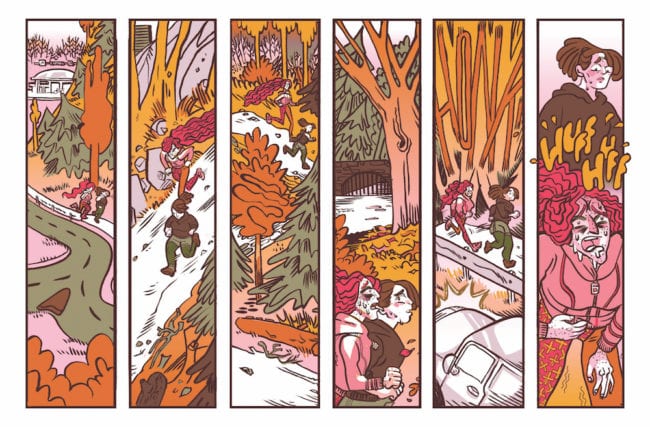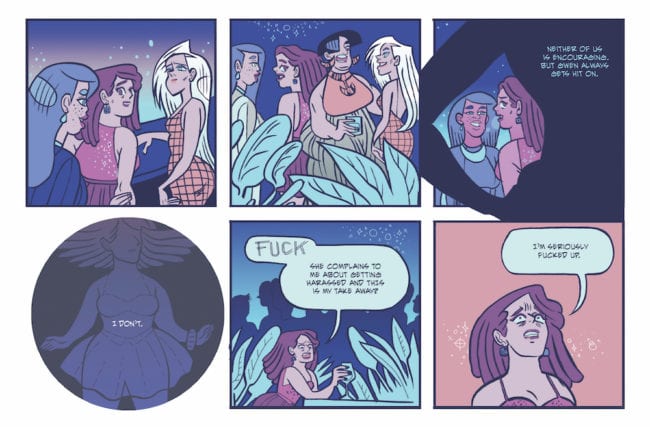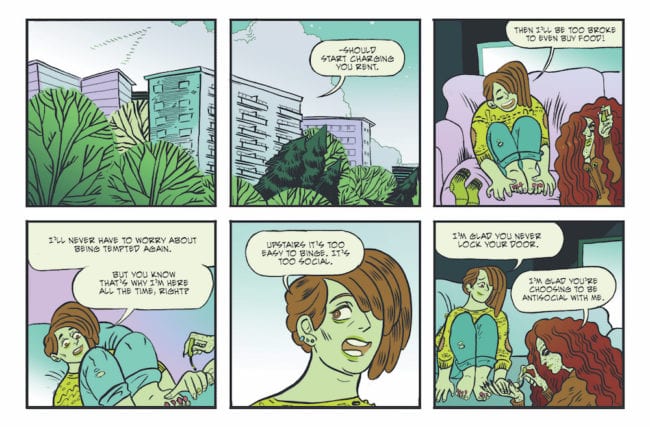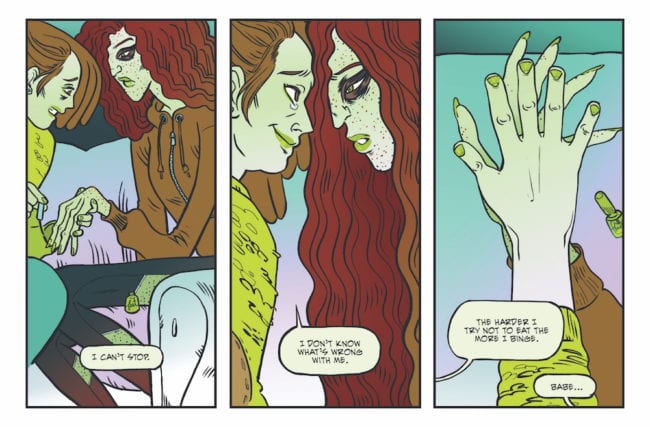In 2012 Kat Verhoeven launched the webcomic Meat and Bone, and though she’s made other projects in the interim – including the serialized graphic novel Towerkind – this story of three friends and roommates in Toronto has always been at the center of her work. Having said that, the comic went through changes over the years, and Verhoeven changed how she worked on it. Like so many long-form early projects it was a learning process, but it’s also where she found her voice as a cartoonist. The collection of the strip has just been published by Conundrum Press and reading the entire run of the comic in one sitting is stunning. The story of a group of women and their struggles captures so much about life in our twenties, but the insights that Verhoeven has into her characters’ struggles with their bodies and their selves, in exploring trauma and growth and resilience, is a punch to the gut that is unflinching and deeply moving. Verhoeven and I spoke recently about how she worked, Toronto, and Jane Fonda.
 Alex Dueben: When you started Meat and Bone you had been making comics and working online for a few years. What did you originally want to do?
Alex Dueben: When you started Meat and Bone you had been making comics and working online for a few years. What did you originally want to do?
Kat Verhoeven: I had done a couple of short comics, mostly fifteen page or shorter zines. I had done some one off comics for fun. For a while I had done some original character battle comics. I think it still happens in corner of the internet and on deviantart, where different high school and college age cartoonists will do round robin style tournaments where they draw comics and whoever’s comic is better wins. There’s different characters and themes and I did a bunch of those for a while. I had been running an illustrated restaurant review blog for about two years and it was doing pretty well. I had just come out of university and I really did not have any money and I was spending all of my money going to restaurants so I could review them. It had been so well received, but it was expensive. I wanted to do something that was food related in some way but also tapped into my passion for comics and was going to use a little more of my illustration ability in a more narrative sense. I thought, I’ve seen eating disorders and these women’s issues touched on within the narrative of other comics, but never as the center of a comic. Though I’ve seen a few now. That’s what was going on in my head at the time I came up with Meat and Bone.
Was the idea from the start to have an ensemble cast and to be about this larger story of multiple characters and community?
Absolutely. When I started it was also meant to be one of those serialized webcomics that goes on indefinitely. I had points I wanted to touch on but I was just writing it on the fly. Maybe seventy pages or so in, a lot of stuff changed. I feel like there’s a big tone shift in that section of the comic. That’s when I realized that I do not write well on the fly. I do work well with a script in advance. I changed how I did my work. Because I’d come up with characters and plot points but I hadn’t come up with a cohesive narrative, a lot of stuff actually never made it into the final book. There are entire subplots that I thought, if I’m ever going to turn this into a self-contained narrative and keep my sanity, I’m going to have to cut loose all this stuff that I had hoped to get to someday.
There was a point where the coloring changed. Was that around same time?
That was also around then. Originally I had a set color scheme and I don’t think I was thinking in terms of branding at that point, but I was thinking, this will be my signature color palette and people will recognize it and know that that’s me. I realized I can’t set the tone for these pages and I can’t convey enough emotion because it was a very neutral color palette and it wasn’t very moving. I thought, why do I have to follow these rules? I can break my own rules. So I completely dropped that idea.
At the start you were thinking of other webcomics like Octopus Pie and Girls with Slingshots.
Absolutely. I get the Octopus Pie comparison fairly often which I think is a compliment. It’s the same format and it was a really big inspiration to me at the time. When I describe the comic I say, it’s like the TV show Friends but sadder. [laughs]
[laughs] I like that. But why did you decide to use a horizontal page design?
I had started working in different printing presses, which is still the day job that I have. I was beginning to get into that work and had started to learn more about paper sizes and page sizes. I was thinking about comic books on shelves and so I mostly did it to try to stand out. Not a lot of comics are done in a horizontal format. Not a lot of long form print comics are done that way. It’s sort of it’s been a bit of a regret actually. As I’ve learned more about webcomic formatting and how to build an audience and make a comic more accessible across different devices, a landscape comic is the worst way of reading that you can have. But it was fun. I wouldn’t do it again but I’m glad Meat and Bone exists in that format. It will stand out on the shelf, I think.
I used word community earlier and this is a story about found family, which is a theme that runs through a lot of your work.
Personally I’ve found my found family to be a much stronger and more important influence than just about any other community or relationship in my life. My friends and the people I’ve chosen to spend my time with have mattered a lot more to me and have been there for me more than my mother or cousins and other relationships. The people who have been around a while who I keep coming back to in my own life are my inspiration. When I started Meat and Bone actually a few of the characters were based on friends of mine, although they very quickly asserted their own voices and quirks and became their own people. When I was first writing it I picked certain people who had really strong personalities just to base characters on.
You said that you wanted to deal with eating disorders and body dysmorphia and how manifests, but can you talk about Anne and Gwen and Jane, because it is first and foremost about characters.
It goes back to basing things on real life. I’ve gone through my own struggles with my body image. I don’t know if a doctor would agree with me that I had an eating disorder, but I wouldn’t eat for long periods of time. I wanted to analyze it and figure it out through art why that was something I kept doing. This was also the time that I had ended this food blog and was running out of money and wanted to start a webcomic. I wanted to work on my own issues through the comic. I always described Meat and Bone as semi-autobiography because a lot of the struggles that Anne goes through are things that I’ve done, or usually exaggerations of things that I’ve done. Other things have been projected onto other characters. Some of it is made up, some of it is based on my own experiences, some of it is an exaggeration, but all of it are things where I can see how this would intertwine and how these types of characters would prop each other up in the areas where they’re weak. So Jane’s confidence is a foil for Anne’s self-loathing. Gwen’s go-and-get-it-ness motivates the other two women even though Gwen is a little bit oblivious to how she has a positive effect on Anne and Jane. I like how they interact as a triad.
Another theme is Gwen’s struggle with polyamory.
How to communicate properly?
Yes, but some of it is also a lack of understanding on her own part about what it means and what it entails.
I think in general with polyamorous communities – or people who just try to figure it out on their own – there are no real set rules about that. I mean there have been versions of polyamory forever, but in terms of the modern perceptions of polyamory it takes a very different angle. People are not trying to engage with the older model of commune polyamory or free love, they’re going out on their own and trying to figure it out. There are resources about how to be polyamorous ethically and responsibly. Gwen is a not impulsive, but passionate and confident and sometimes her passion and confidence makes her think that she doesn’t need to do as much research. So she’ll jump into something and then be like, wait, no. I could have thought this through more.
Years ago in an interview about Drawn and Devoured, you said “I am no longer an under-appreciator of community, or the power of staying connected. I suppose running Drawn and Devoured, creating it, has forged an optimist out of me, and has helped awaken my community spirit.” How do you think that played a role in making Meat and Bone and your work since, more generally?
When I was doing the food blog, that community was very active and social. Once I started going back to comics, it’s not quite the same level of engagement, actually. I have come back around to struggling with this idea of community. I’m not really sure how it affects the writing of the story. I do like looking at how people rely on each other in ways that they do and don’t want to. How a community can help you when you’re maybe not helping yourself. That’s the crescendo of the book. Community is a really complicated subject and it’s a really hard thing to maintain and it requires maintenance.
The comic really captures that emotional feel of life in our twenties.
Exactly. Everything is up in the air. I think a lot of the characters are vulnerable even when they don’t think they are. There’s a lot of messy insecurity in the early twenties. Not for everybody, but for a lot of people I know, anyhow.
One aspect of comic is Anne and her idol Barbarella and you seem to have fun drawing those fantasy pages. Where did this idea come from?
It’s a bit dated, I guess. Anne and Jane go to the bookstore and talk about this Jane Fonda workout book. That was a book I had and I was reading it and doing the actual workouts from it. There is a really interesting forward where Jane Fonda talks about how she went through a lot of body image issues and she was anorexic. How it used to be almost a fashion thing with her and her friends and they would compete to see who would have the worst eating habits. It was a really honest and revealing look at the cost of fame and how she rejected that and tried to focus more on health and how it improved her mindset and her physical health and how she felt about herself. Even though she’s still a very fashionable, beautiful older woman, it really moved me how there is such a difference between focusing on being thin and being healthy. I could see somebody like Anne coming to that same conclusion but also getting a little carried away by the bad aspect of it. I thought it was fun to have an idol who’s really gorgeous and very iconic and also flawed, but definitely as an icon, an unattainable space princess, really. Anne is never going to be able to achieve those things. It’s a poor choice of role model for her.
Jane – the character not the actor – has a line about how she doesn’t want to be thin, she wants to be strong.
That’s the Jane that Anne should listen to.
Your previous book, Towerkind, was also published by Conundrum. When you started thinking about collecting the comic, how did you end up at Conundrum and working with Andy Brown?
This was a much bigger deal workwise than Towerkind. Towerkind was black and white, it was just inkwork, and I had been printing it as I went. It started out as a subscription comic. I would mail people a comic every month. Like [Chuck Forsman's] End of the Fucking World, you would get a real physical object every month. It was also a challenge for me to put out a comic at a certain time and keep that up. It was shorter, only 150 pages, where as Meat and Bone is 350 pages. I’d been working on it before I ever started Towerkind. Some of those files were in a terrible state. There were the wrong size, the wrong dpi, and there was a lot more fixing to do for Meat and Bone. There were also scenes that I wanted to redraw and finish coloring so it’s been a lot more work getting this book together. I think I was at the end of my rope because I was moving then and Andy helped a lot.
You live in Toronto and the book is set there and how has the city influenced your work?
I came here for school in 2005. I went away for two years but otherwise I’ve lived in Toronto ever since. I noticed that a lot of comics were set in the states or in some ambiguous place and there wasn’t anything really Canadian and I wanted to make Canadian comics. The city comes up in Towerkind and Meat and Bone constantly. The graffiti is all Toronto graffiti. I’m drawing art from artists who are making their marks all over the city. There are landmarks and specific alleys and tiny little things that I don’t think even people from Toronto will notice, but I notice them because they mean something to me. So every page is very Toronto centric.
You’ve finished this massive book which you have in your hands. You started this in 2012?
It’s been so long and I had to change the original website so I don’t actually have the launch date. I know I launched it for TCAF and it was 2012, so it’s been a long time coming. I do feel really good and proud and amazed – but of course I wouldn’t be a real cartoonist if I wasn’t thinking, well why didn’t it take less time and other doubts and criticisms from inside.
After any long project, I think it’s inevitable to look back and go, I should have done this or I could have saved time and energy if I did that. Your process changes over time.
Especially with webcomics, a person’s first big project has a huge learning curve. My process at the beginning of working on Meat and Bone is completely different from how it was by the end. At the end I got quite fast. Even with more happening in my personal life and professional life, I got better at juggling time and making the work. I had this rule when I started Meat and Bone where I was never going to redraw anything. Once the ink was done, that was it. Tough luck. A lot of those early pages are super ugly because of this rule I made. But sticking to the rule, I got better at drawing and made fewer mistakes as I went. I actually did the last 200 pages or so into a black artist sketchbook, like you’ll see at any store. I would draw the pencil on there and then ink right over those and scan from the book. I just kept them in sequence and never redrew anything. So gaining speed was one of my main goals and I definitely got that in the end, which is pretty cool. From a personal point of view, that was a really good accomplishment.
Before you sat down to pencil and ink like that were you writing and sketching?
No. I had a written script and I would do a layout thumbnail next to the script pages. That was mostly because I was trying to plan for the book so I wanted to make sure that the spreads weren’t really awkward. So I basically had panel layouts and maybe a figure if it was important and then I would go right into the sketchbook and draw a page and ink it. I have one friend of mine who’s a really talented cartoonist and his process is so laborious because he does at least two rounds of pencils and then he lightboxes and he inks and it takes him much longer to finish a page – although his pages are extremely tight. I just never wanted to spend that much time. I wanted to get the story out.
Do you draw tight pencils?
I’ll do a framework first and make sure that fits and there’s room for the speech bubbles, but then I’m pretty much drawing what will be the final inks. Unless something’s really fighting me, which does happen, but I try to have a really clear idea of what I want.
So once you set those limits and started writing, that freed you up in other ways?
It let me plan ahead so if there was something that I knew I wanted to bring back over and over again, I could plan. There’s this one line Anne has, “I have a pretty face” that comes up three or four times. In terms of the drawing, I wanted it to have that immediacy. There’s a bit of frantic quality to my line art in a way that I really like. I don’t find imperfections to be a turnoff in art. I think they can add personality. It was really more just as I got comfortable drawing this way and gained confidence in this work, this is how I liked to work. It’s more joyful for me to work quickly and to not make it a chore. It’s more about drawing still being fun and not just a job that I gave to myself.
Do you see yourself making another project on the fly?
I think going forward I’m always going to write a script. Or at the very least I’m going to write a first draft. I think the next book will be a short one – so under 200 pages. Maybe 150 pages? I’d like to try batch work, so doing all of the pencils and then all of the inks, just because I think that’s a smart way to work to keep a book consistent. Especially if you’re doing something where you know you’ll be working on it for a couple years. Otherwise the beginning of the book is going to look very different from the end. But in general, I don’t mind working on the fly. It’s fun.
It sounds like you have the next project in mind.
I have a folder full of ideas that I would like to narrow down. I have two stories that I’m particularly drawn to, but whether either of those is going to be the one I work on, I’m not sure yet. I’m starting to get that energy and that restless urge to create again now. For a few months I just needed to finish the book and move and get a job and I just didn’t have the mental energy to think about the next big project.
I don’t know if you’ve ever had a stretch where you’re working really hard for weeks and when you’re done the first thing that happens is you get a cold? It’s kind of been like that but for my brain. I think I’m recovering from my cold. I do admire the people who finish something and pick up something immediately and hit the ground running every single time but that’s not me unfortunately.
Do you see yourself making another webcomic?
I don’t know. I like the engagement of doing a webcomic, but I think how I work and write and the pacing that I’m drawn to is kind of slow for a webcomic. I think my work definitely lends itself more to books. I’m not against doing another webcomic, I’m just not sure if that’s what will happen.
Are you doing a lot of events this year now that the book is out?
TCAF is always the big one. Anyone who’s into comics and is in New York state or Ontario, they should come to TCAF because it’s an amazing show. The organizers really care about making it better every single year and it’s honestly my favorite show out of all the shows I’ve been to in North America. Maybe because it’s my home show, but it truly is well organized. I will be on the West Coast and at Vancaf at the end of May and I’m really looking forward to being back. My art collective Friendship Edition will be at CAKE in Chicago and I may or may not go with them. I’m waiting to see what’s going on with SPX.
Will you be doing any events in Montreal given the mockery of the city in the book?
Oh, absolutely. Montreal is a fantastic city to visit. And it’s a very Toronto thing for everyone to constantly mock Montreal while saying that they’re going to move there. I think it’s maybe the way people in the U.S. talk about moving to Portland?












